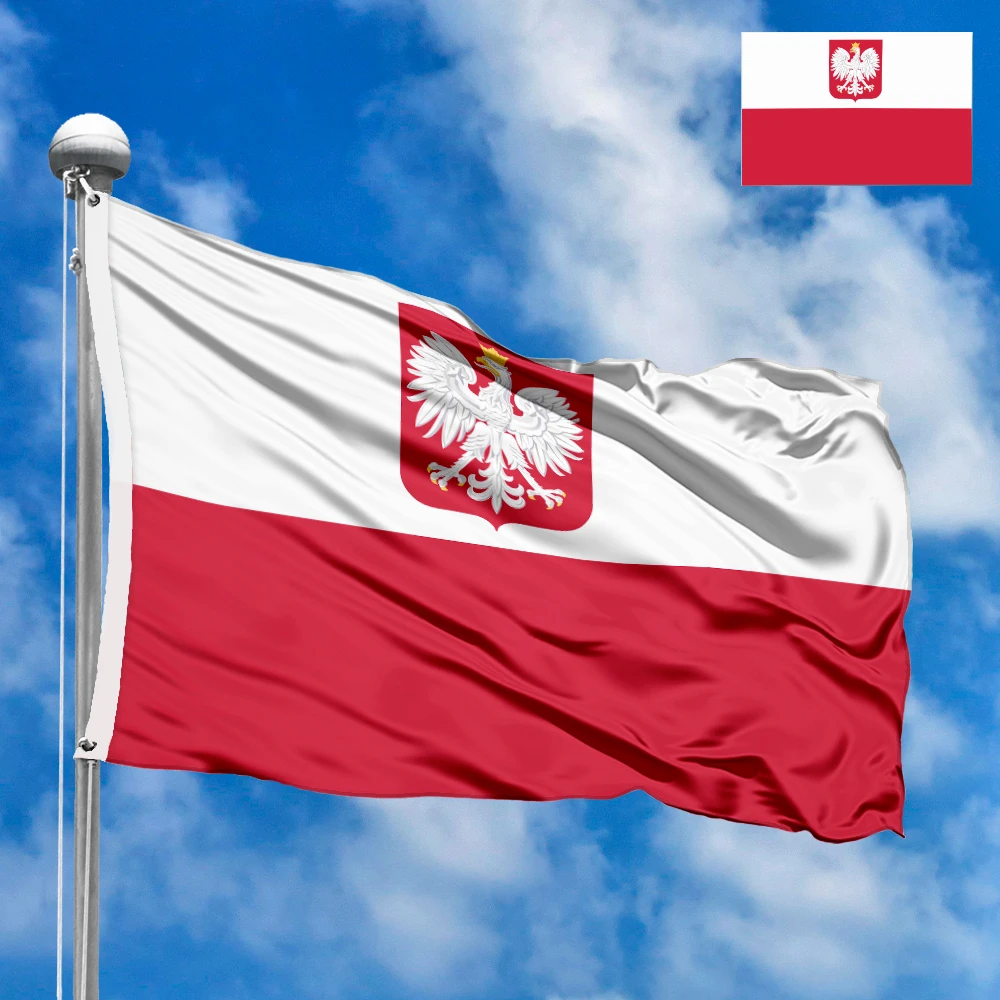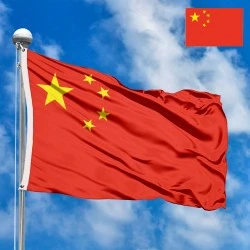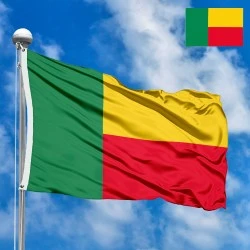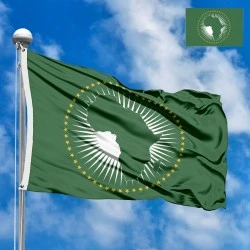Flag of Hong Kong
- Flag Type: Regional
- Proportions (official): 2:3
- Official name: Hong Kong Special Administrative Region of the People's Republic of China
- Local name: 香港特別行政區, Hong Kong Special Administrative Region
- Sovereignty (year): NO (SAR of PRC since 1997)
- Country code, territory: HK, HKG, 344
- Population: ~7,500,000 (2024, C&SD)
- Religions: Buddhism/Taoism ~49%, Christianity ~12%
- Area (km²): 2 755
- Highest point: Tai Mo Shan (957 m)
- Lowest point: South China Sea (0 m)
- Currency: Hong Kong dollar (HKD, $)
- Languages: Cantonese, English
- Dialing code: +852
- National domain: .hk
Flag Information
General information
Demography and Culture
Economy and communications
- All Flags
- Flags of Countries by Continent
-
Flags of Organizations
- Flags of UN countries
- Flags of the European Union countries
- Flags of NATO countries
- Flags of the countries of the Organization of Islamic Cooperation
- Flags of the countries of the Organization of American States
- Flags of the Arab League countries
- Flags of the African Union countries
- Flags of the countries of the Union of South American Nations
- Flags of the Commonwealth of Nations
- Flags of the countries of the Secretariat of the Pacific Community
- Flags of the Nordic Council countries
- Flags of the Caribbean Community
- Flags of the countries of the Association of Southeast Asian Nations
- Flags of the East African Community
- Flags of the countries of the Organization of Turkic States
- LGBT Community Flags
- Historical Flags
- Ethnic Flags
- Flags of the USA (states)
Description
The Regional Flag of the Hong Kong Special Administrative Region of the People's Republic of China is a powerful emblem, intricately woven with the unique identity, complex history, and enduring aspirations of its people. Adopted on April 4, 1990, and officially hoisted on July 1, 1997, during the historic handover from British rule to Chinese sovereignty, this flag beautifully encapsulates the principle of "One Country, Two Systems" and Hong Kong's distinctive path. Understanding its design, historical context, and profound significance offers an illuminating journey into this vibrant global city.
A Visual Symphony: Description, Dimensions, and Element Arrangement
The Hong Kong flag features a red field, a color deeply symbolic in Chinese culture, representing felicity, celebration, and the spirit of the motherland. This vibrant background serves as the canvas for a stylized, five-petaled white bauhinia blakeana flower positioned centrally. The bauhinia, a hybrid orchid tree, is Hong Kong's floral emblem, chosen for its local significance and the fact that it only grows in Hong Kong. It represents the region's unique identity and its enduring beauty. Each of the five petals of the white bauhinia features a small red five-pointed star at its center, with a stylized red curved line spiraling outwards from the star, giving the impression of movement and vitality. These five red stars echo the five stars on the national flag of the People's Republic of China, symbolizing Hong Kong's inextricable link to the motherland and acknowledging its distinct administrative status within China. The design is deliberately symmetrical and harmonious, emphasizing unity and balance.
While precise official dimensions for website display are flexible, the flag's ratio is typically 2:3 (height to width), mirroring the standard for many national and regional flags. This conventional proportion ensures visual consistency and ease of reproduction across various media, from monumental flagpoles to digital platforms. The specific shades of red and white are precisely defined by the government to ensure consistency in reproduction, maintaining the flag's integrity and symbolism. The red is a bright, clear hue, vibrant and celebratory, while the white of the bauhinia is pristine and sharp, highlighting its purity and prominence against the red field.
Echoes of Time: The History of the Flag's Creation
The genesis of Hong Kong's flag is inextricably linked to the impending transfer of sovereignty from the United Kingdom to China. Following the signing of the Sino-British Joint Declaration in 1984, which set out the framework for Hong Kong's future as a Special Administrative Region (SAR), the need for a distinct regional flag and emblem became a crucial part of defining its autonomy.
A public competition for the design of the flag and emblem was launched in Hong Kong in May 1987, inviting submissions from residents. This initiative was designed to foster a sense of local ownership and ensure that the chosen design genuinely resonated with the aspirations of the people. From over 7,000 designs submitted by Hong Kong residents and from mainland China, six finalists were selected. However, none of these initial finalists were ultimately chosen. Instead, the Basic Law Drafting Committee for the Hong Kong SAR, along with a team of artists and designers, decided to develop a new design based on the core principles and preferred elements observed in the submitted entries.
The winning concept, which forms the basis of the current flag, was created by Tao Ho (何弢), a prominent Hong Kong architect. His design ingeniously integrated the bauhinia blakeana, a flower endemic to Hong Kong and often referred to as the "Hong Kong Orchid Tree." This choice perfectly symbolized Hong Kong's unique identity, its beauty, and its special place. The five red stars within the petals were a direct nod to the five stars on China's national flag, signifying Hong Kong's return to the motherland while retaining its distinct character under the "One Country, Two Systems" framework. The dynamic, spiraling lines from the stars represented not only the petals but also the vitality and progress of Hong Kong. The red background, already a strong national symbol for China, also carries connotations of celebration and prosperity, fitting for Hong Kong's vibrant spirit.
The final design was approved by the National People's Congress of China on April 4, 1990, and formally promulgated as part of the Basic Law of the Hong Kong Special Administrative Region. Its adoption was a pivotal moment, marking a definitive step in Hong Kong's transition towards its new political and administrative identity.
Hong Kong's Identity Woven in Fabric: Significance for the Region
The flag holds profound significance for Hong Kong, acting as a powerful symbol of its autonomy, prosperity, and unique cultural blend. It visually articulates the "One Country, Two Systems" principle, under which Hong Kong enjoys a high degree of autonomy, maintaining its own legal system, currency, customs territory, and even its own immigration policies, distinct from mainland China. The flag is a constant reminder of this special status, guaranteeing a capitalist system and way of life for 50 years after the handover.
For the residents of Hong Kong, the flag embodies their local identity and pride. It represents their history as a dynamic global hub, a place where East meets West, and a testament to their resilience and entrepreneurial spirit. The bauhinia, blooming vibrantly on the red field, can be interpreted as Hong Kong's enduring prosperity and unique character. The flag is displayed prominently on government buildings, schools, and during public holidays, serving as a unifying emblem that fosters a sense of community and belonging among its diverse population. It stands as a testament to Hong Kong's successful transition and its continued development under the Basic Law, reflecting its unique blend of Chinese heritage and international outlook.
Intriguing Facets: Interesting Facts about the Hong Kong Flag
-
A Symbol of "One Country, Two Systems": The flag is perhaps the clearest visual representation of the "One Country, Two Systems" principle. The national color red and the five stars connect Hong Kong to China, while the unique bauhinia flower emphasizes Hong Kong's distinct identity and high degree of autonomy.
-
The Bauhinia Blakeana: This flower is not only the symbol on the flag but also a real, beautiful tree that can be found blooming throughout Hong Kong. It's a hybrid, meaning it doesn't reproduce through seeds, making its propagation reliant on human intervention, which some see as a metaphor for Hong Kong's unique man-made success.
-
Historical Precedent: Before 1997, the flag flown over Hong Kong was the colonial flag of British Hong Kong, which featured a Blue Ensign with the Hong Kong crest. The current SAR flag marked a dramatic visual shift in sovereignty and identity.
-
Symbolism of the Five Stars: The five stars within the bauhinia petals represent Hong Kong's citizens, aligning themselves with the five stars on the Chinese national flag. The design intends to convey unity and harmony between Hong Kong and the mainland.
-
Designer's Vision: Tao Ho, the flag's designer, intended the bauhinia to symbolize Hong Kong's unique status and prosperity, and the five red stars within its petals to signify that Hong Kong is an integral part of China, while maintaining its distinctiveness.
-
Architectural Integration: The bauhinia motif is extensively used in Hong Kong's public art, architecture, and even currency, further embedding its symbolism into the fabric of the city.
-
Strict Proportions: Like many national flags, the Hong Kong SAR flag has very specific construction sheet details defining the exact placement, size, and curve of the bauhinia and stars, ensuring precise reproduction.
The Moment of Transition: Adoption and Reception
The official adoption of the Hong Kong SAR Flag occurred on April 4, 1990, when it was formally approved by the Third Session of the Seventh National People's Congress of the People's Republic of China. This legislative approval was a critical step, cementing its status as the official emblem of the future Special Administrative Region.
However, the most globally significant moment of its adoption came on July 1, 1997, at midnight, during the solemn and historic handover ceremony. As the British Union Flag was lowered for the last time, the new Regional Flag of the Hong Kong Special Administrative Region, alongside the national flag of the People's Republic of China, was raised for the first time over Hong Kong. This moment, witnessed by dignitaries from around the world and broadcast globally, marked the official return of Hong Kong to Chinese sovereignty after 156 years of British administration. The raising of the flag was met with immense emotion and varying sentiments by residents, symbolizing a new and profoundly significant chapter in Hong Kong's history. The reception was complex; while many embraced the new era and its symbols, others viewed it with apprehension, reflecting the diverse perspectives within Hong Kong regarding its future under the "One Country, Two Systems" framework. Nevertheless, the flag became the undeniable visual representation of this new era.
A Beacon of Hope: Meaning for Residents
For the people of Hong Kong, the flag is more than just a national symbol; it is a beacon of their unique identity, resilience, and enduring spirit. It represents the culmination of a peaceful and historic transition, ensuring that Hong Kong maintains its distinct way of life, its economic vibrancy, and its cultural heritage. The bauhinia flower, blooming vibrantly on the red field, is seen by many as a metaphor for Hong Kong itself – a resilient entity that has weathered historical changes and continues to thrive as a dynamic global city.
The red background connects them to the vastness of China, acknowledging their place within the broader nation, while the unique bauhinia champions their local autonomy and distinctiveness. It speaks to the promise of "One Country, Two Systems," fostering a sense of continuity and confidence in their future. For many, it represents a sense of belonging, a visual affirmation of their home's special status on the global stage, and a source of collective pride in their unique cultural fusion, economic dynamism, and unwavering spirit. The flag unites residents of diverse backgrounds, reminding them of their shared destiny and the complex yet promising prospects that lie ahead for the Hong Kong Special Administrative Region.
In the demonstration images, full-size flags are shown with proportions of 2:3, and hand-held flags with proportions of 1:2.
Donation
Download
Completely free for commercial and non-commercial use (public domain).
You can freely use them in your news magazines, websites, software, mobile applications.
We appreciate a backlink to https://flagssite.com
Raster files - Flag of Hong Kong (PNG, JPG)
 Waving flag
Waving flag
- PNG format (transparent background), 72dpi, dimensions in Pixels (px), aspect ratio 3:4.
- 15х20 px
- 30х40 px
- 60х80 px
- 120x160 px
- 240x320 px
 Sizes:
Sizes:
"v15" - image size (by height); if necessary, replace with available: v15, v30, v60, v120, v240.
!!! For resizing, use the Latin (eng) keyboard layout.
<img src="https://flagssite.com/flags/v15/20349.png" alt="Flag of Hong Kong">
 Round flag
Round flag
- PNG format (transparent background), 72dpi, dimensions in Pixels (px), aspect ratio 1:1.
"d15" - image size (diameter); if necessary, replace with available: d15, d30, d60, d120, d240.
!!! For resizing, use the Latin (eng) keyboard layout.
<img src="https://flagssite.com/flags/d15/20349.png" alt="Flag of Hong Kong">
 Rectangular flag 2:3
Rectangular flag 2:3
- JPG format, 72dpi, dimensions in Pixels (px), aspect ratio 2:3.
"h30" - image size (by height); if necessary, replace with available: h15, h30, h60, h120, h240, h360, h480.
!!! For resizing, use the Latin (eng) keyboard layout.
<img src="https://flagssite.com/flags/h30/20349.jpg" alt="Flag of Hong Kong">









 Sizes:
Sizes:
 Sizes:
Sizes:

























